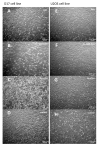Enhanced Cytotoxic Effect of Doxorubicin Conjugated to Glutathione-Stabilized Gold Nanoparticles in Canine Osteosarcoma-In Vitro Studies
- PMID: 34201296
- PMCID: PMC8227216
- DOI: 10.3390/molecules26123487
Enhanced Cytotoxic Effect of Doxorubicin Conjugated to Glutathione-Stabilized Gold Nanoparticles in Canine Osteosarcoma-In Vitro Studies
Abstract
Osteosarcoma (OSA) is the most common malignant bone neoplasia in humans and dogs. In dogs, treatment consists of surgery in combination with chemotherapy (mostly carboplatin and/or doxorubicin (Dox)). Chemotherapy is often rendered ineffective by multidrug resistance. Previous studies have revealed that Dox conjugated with 4 nm glutathione-stabilized gold nanoparticles (Au-GSH-Dox) enhanced the anti-tumor activity and cytotoxicity of Dox in Dox-resistant feline fibrosarcoma cell lines exhibiting high P-glycoprotein (P-gp) activity. The present study investigated the influence of Au-GSH-Dox on the canine OSA cell line D17 and its relationship with P-gp activity. A human Dox-sensitive OSA cell line, U2OS, served as the negative control. Au-GSH-Dox, compared to free Dox, presented a greater cytotoxic effect on D17 (IC50 values for Au-GSH-Dox and Dox were 7.9 μg/mL and 15.2 μg/mL, respectively) but not on the U2OS cell line. All concentrations of Au-GSH (ranging from 10 to 1000 μg/mL) were non-toxic in both cell lines. Inhibition of the D17 cell line with 100 μM verapamil resulted in an increase in free Dox but not in intracellular Au-GSH-Dox. The results indicate that Au-GSH-Dox may act as an effective drug in canine OSA by bypassing P-gp.
Keywords: P-glycoprotein; dogs; doxorubicin; flow cytometry; gold; humans; nanoparticles; osteosarcoma.
Conflict of interest statement
The authors declare no conflict of interest.
Figures







Similar articles
-
Enhancing anti-tumor efficacy of Doxorubicin by non-covalent conjugation to gold nanoparticles - in vitro studies on feline fibrosarcoma cell lines.PLoS One. 2015 Apr 30;10(4):e0124955. doi: 10.1371/journal.pone.0124955. eCollection 2015. PLoS One. 2015. PMID: 25928423 Free PMC article.
-
Doxorubicin Conjugated to Glutathione Stabilized Gold Nanoparticles (Au-GSH-Dox) as an Effective Therapeutic Agent for Feline Injection-Site Sarcomas-Chick Embryo Chorioallantoic Membrane Study.Molecules. 2017 Feb 8;22(2):253. doi: 10.3390/molecules22020253. Molecules. 2017. PMID: 28208720 Free PMC article.
-
GSH-responsive Pt-based nanomotor with improved doxorubicin delivery for synergistic osteosarcoma chemotherapy.Acta Biomater. 2025 Mar 15;195:390-405. doi: 10.1016/j.actbio.2025.02.004. Epub 2025 Feb 6. Acta Biomater. 2025. PMID: 39921180
-
Cytotoxicity and apoptosis of nanoparticles on osteosarcoma cells using doxorubicin and methotrexate: A systematic review.Eur J Pharmacol. 2021 Aug 5;904:174131. doi: 10.1016/j.ejphar.2021.174131. Epub 2021 Apr 30. Eur J Pharmacol. 2021. PMID: 33933464
-
Canine osteosarcoma in comparative oncology: Molecular mechanisms through to treatment discovery.Front Vet Sci. 2022 Dec 8;9:965391. doi: 10.3389/fvets.2022.965391. eCollection 2022. Front Vet Sci. 2022. PMID: 36570509 Free PMC article. Review.
Cited by
-
Exosomes in Bone Cancer: Unveiling their Vital Role in Diagnosis, Prognosis, and Therapeutic Advancements.J Cancer. 2024 Jun 3;15(13):4128-4142. doi: 10.7150/jca.95709. eCollection 2024. J Cancer. 2024. PMID: 38947401 Free PMC article. Review.
-
Co-Treatment of Caco-2 Cells with Doxorubicin and Gold Nanoparticles Produced from Cyclopia intermedia Extracts or Mangiferin Enhances Drug Effects.Nanomaterials (Basel). 2022 Nov 7;12(21):3918. doi: 10.3390/nano12213918. Nanomaterials (Basel). 2022. PMID: 36364694 Free PMC article.
-
Application of Biocompatible Drug Delivery Nanosystems for the Treatment of Naturally Occurring Cancer in Dogs.J Funct Biomater. 2022 Aug 7;13(3):116. doi: 10.3390/jfb13030116. J Funct Biomater. 2022. PMID: 35997454 Free PMC article. Review.
-
Doxorubicin Loaded Gold Nanoparticles Mitigate Liver Fibrosis and Inflammatory Cytokines Gene Expression in Rat.Recent Adv Drug Deliv Formul. 2022;16(4):309-316. doi: 10.2174/2667387817666221020090050. Recent Adv Drug Deliv Formul. 2022. PMID: 36278442
-
Carnosine Potentiates Doxorubicin-Induced Cytotoxicity in Resistant NCI/ADR-RES Cells by Inhibiting P-Glycoprotein-In Silico and In Vitro Evidence.Molecules. 2022 Oct 30;27(21):7383. doi: 10.3390/molecules27217383. Molecules. 2022. PMID: 36364209 Free PMC article.
References
MeSH terms
Substances
Grants and funding
LinkOut - more resources
Full Text Sources
Miscellaneous

